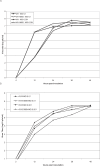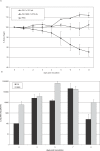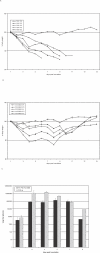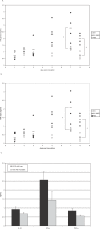A single mutation in the PB1-F2 of H5N1 (HK/97) and 1918 influenza A viruses contributes to increased virulence
- PMID: 17922571
- PMCID: PMC2000966
- DOI: 10.1371/journal.ppat.0030141
A single mutation in the PB1-F2 of H5N1 (HK/97) and 1918 influenza A viruses contributes to increased virulence
Abstract
The proapoptotic PB1-F2 protein of influenza A viruses has been shown to contribute to pathogenesis in the mouse model. Expression of full-length PB1-F2 increases the pathogenesis of the influenza A virus, causing weight loss, slower viral clearance, and increased viral titers in the lungs. After comparing viruses from the Hong Kong 1997 H5N1 outbreak, one amino acid change (N66S) was found in the PB1-F2 sequence at position 66 that correlated with pathogenicity. This same amino acid change (N66S) was also found in the PB1-F2 protein of the 1918 pandemic A/Brevig Mission/18 virus. Two isogenic recombinant chimeric viruses were created with an influenza A/WSN/33 virus background containing the PB1 segment from the HK/156/97: WH and WH N66S. In mice infected with WH N66S virus there was increased pathogenicity as measured by weight loss and decreased survival, and a 100-fold increase in virus replication when compared to mice infected with the WH virus. The 1918 pandemic strain A/Brevig Mission/18 was reconstructed with a pathogenicity-reducing mutation in PB1-F2 (S66N). The resultant 1918 S66N virus was attenuated in mice having a 3-log lower 50% lethal dose and caused less morbidity and mortality in mice than the wild-type virus. Viral lung titers were also decreased in 1918 S66N-infected mice compared with wild-type 1918 virus-infected mice. In addition, both viruses with an S at position 66 (WH N66S and wt 1918) induced elevated levels of cytokines in the lungs of infected mice. Together, these data show that a single amino acid substitution in PB1-F2 can result in increased viral pathogenicity and could be one of the factors contributing to the high lethality seen with the 1918 pandemic virus.
Conflict of interest statement
Figures





References
-
- Beveridge WI. The chronicle of influenza epidemics. Hist Philos Life Sci. 1991;13:223–234. - PubMed
-
- Nguyen-Van-Tam JS, Hampson AW. The epidemiology and clinical impact of pandemic influenza. Vaccine. 2003;21:1762–1768. - PubMed
-
- World Health Organization. Acute respiratory infections: Influenza. 2007. Available at: http://www.who.int/vaccine_research/diseases/ari/en/. Accessed 30 April 2007.
Publication types
MeSH terms
Substances
Grants and funding
LinkOut - more resources
Full Text Sources
Other Literature Sources
Medical
Miscellaneous

